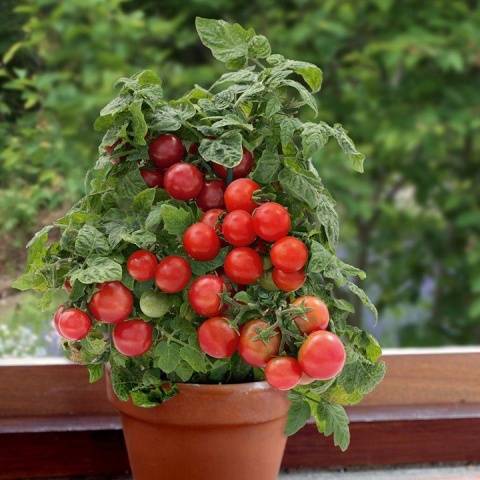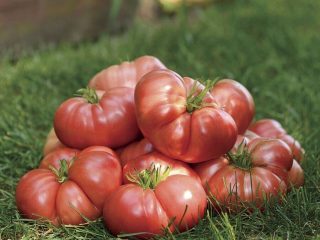Content
After collecting information about the variety and reading reviews, the gardener often makes his choice in favor of the Linda tomato. But when he goes to get the seeds, he encounters a certain problem: it turns out that there are two varieties of tomatoes with that name. And these are two completely different tomatoes. The first Linda tomato is a fruit of domestic selection, belonging to the cherry subspecies, the second tomato is called Linda F1 and is the result of the work of Japanese breeders, bears large, beautiful fruits.
Characteristics and descriptions of tomato varieties called Linda can be found in this article. A photo of a bush of two varieties will also be presented here, and the key rules for growing each of these tomatoes will be described.
Characteristic
Linda tomatoes have ultra-early ripening periods. This plant belongs to the determinate type and bears small cherry fruits. This variety of tomato is intended for growing indoors, so it can often be found on balconies and loggias; it also grows well in a room, on a windowsill.
Detailed description of the Linda variety:
- varietal type tomato, that is, the owner will be able to collect seeds from his own fruits and sow them again next season;
- the plant is of a determinate type, which means it has a terminal growth point;
- the height of the bushes rarely exceeds 25-30 cm;
- the first fruit cluster is tied after the seventh leaf;
- leaves are dark green, stems are dense;
- the bushes do not need to be tied up, they are powerful enough to support the weight of the crop;
- tomatoes are set on fruit clusters, which in their structure resemble bunches of grapes;
- the fruits are round, even and smooth, colored deep red;
- the average weight of Linda tomatoes is 25-30 grams;
- the variety's yield is high (as for cherry tomatoes) - up to three kilograms per square meter;
- The planting pattern is dense - 7-8 bushes can be grown per square meter of land;
- The tomato is resistant to fusarium, leaf spot and verticillium.
Gardeners call the Linda tomato variety tomatoes for the lazy, so this is an excellent option for beginners or very busy owners.
Small, dense tomatoes are great for pickling or pickling, they make excellent salads, sauces, red fruits look impressive and as a decoration for various dishes.
Rules for growing miniature tomatoes Linda
As has already become clear from the description, tomatoes of this variety are very easy to grow. Tomato Linda is perfect for those who live in city apartments and do not have their own plot of land.A couple of bushes of this tomato can feed a family with delicious and healthy fresh vegetables.
The stages of growing cherry tomatoes are as follows:
- In late March tomato seeds are sown in the ground. If Linda is grown indoors, you can immediately sow the tomatoes in permanent containers. When tomatoes are going to be brought into the garden, you first need to grow seedlings.
- The soil for planting tomatoes should be loose and nutritious. Good drainage is essential so that excess moisture does not stagnate in the ground. The seeds are buried 1-2 cm into the soil, sprinkled with a thin layer of dry soil on top and the soil is sprayed with water.
- As soon as the first shoots appear, tomatoes should be feed with a complex of mineral fertilizers. Tomatoes need to be fertilized at least two more times: at the stage of formation of flower ovaries and during the period of fruit laying.
- In order for the bush to develop well, you can treat it with some growth stimulator for tomatoes. For example, the special composition “Vympel” is suitable.
- Watering the tomatoes should be done carefully; in small bushes the roots are located close to the surface, they are easy to wash. The land is irrigated as it dries out, using settled water at room temperature.
- To ensure that tomatoes have enough sunlight, pots or boxes with plants are placed on window sills or placed on balconies or loggias. As practice shows, Linda tomatoes do not need to be additionally illuminated – they tolerate a lack of light well, are not delayed in development and produce the same abundant harvest.
- The first fruits can be collected in early June. Usually tomatoes ripen in whole bunches. Fruiting of the Linda tomato is extended - the bushes will produce fresh tomatoes from June to the end of September.
Tomato Linda F1 and its features
This tomato is a hybrid, bred by Japanese breeders. Linda F1 is very different from its “tesque”, because it is a medium-sized bush with a thick stem and large fruits.
The characteristic features of the hybrid are as follows:
- mid-early fruiting - from 101 to 106 days after emergence;
- bushes of determinant type, need proper formation;
- the stems are thick and powerful, the leaves are large;
- plant height often exceeds 70-80 cm;
- the Linda F1 tomato is recommended for growing in open ground, although the hybrid also bears fruit well in an unheated greenhouse;
- the fruits have a rounded-flattened shape;
- the peel of the tomatoes is dense, the flesh is also elastic, they are painted bright red;
- The tomato tastes pleasant, sweet and sour, good enough for a hybrid;
- the fruits have excellent shelf life and are suitable for transportation;
- the weight of tomatoes varies greatly - from 100 to 350 grams;
- the hybrid is resistant to fusarium and verticillium, tomatoes are rarely affected by blight;
- The hybrid yield is high.
The Linda F1 tomato variety is excellent for growing for commercial purposes, which is why farmers and gardeners from all over the country love it. The appearance of the fruit is highly marketable. The tomato is suitable for fresh consumption, whole fruit canning, preparing salads, hot dishes, sauces and juices.
The hybrid is distinguished by its durability and unpretentiousness; tomatoes of this type are planted even in large farm fields.
Features of cultivation
A gardener will not have any troubles with a hybrid tomato: the tomato does not require complex care, rarely gets sick, and pleases with stable and abundant harvests.
To grow Linda F1 tomato you need to do this:
- 55-60 days before the intended planting in the ground, it is necessary sow seeds for seedlings. Hybrid seedlings are grown in the same way as always: the seeds are laid out on nutritious loose soil, sprinkled with earth or peat and irrigated with water.
- The first shoots should appear under the film in a warm place in 5-6 days. Now the tomato seedlings are transferred to a bright place.
- When the plants have two true leaves, tomatoes dive - transplanted into separate containers.
- During the dive phase, it is recommended to perform the first feeding Linda. To do this, it is better to use a mineral complex intended for tomatoes.
- Tomatoes are planted in a permanent place according to the scheme - 4 bushes per square meter.
- Caring for tomatoes is simple: regular watering (preferably drip), fertilizing, weeding, protection from diseases and pests.
- This hybrid needs to be taken care of: usually the first stepson is left under the flower ovary, and the second immediately above it. Linda can be grown in one, two or three stems.
- The bush does not need tying, since its stems are quite powerful.
The gardener must understand that the seeds of hybrid tomatoes will cost several times more than planting material for varietal crops. This is understandable, because to obtain a hybrid, breeders have to do long and painstaking work. In addition, the gene does not remain in its pure form for more than one season - it will not be possible to collect seeds from your own harvest.
Review
Results
Two tomatoes with the same name turned out to be completely different. They have only one thing in common - Linda tomatoes will not cause trouble to the gardener, because they are very unpretentious.
Varietal Linda is suitable for growing indoors and will decorate balconies and verandas. Small, tasty fruits diversify your home menu and serve as a decoration for salads and other dishes.
Hybrid tomato is best grown in spacious areas, farm fields, but it is also quite suitable for a small country garden or a simple greenhouse. These fruits will delight you with their size, fleshy pulp and long shelf life.





















